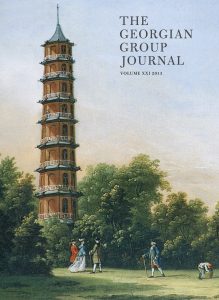| Author |
Article |
Pages |
| Patricia Smith |
“Contriving Lord Conway’s House”: Who really designed Ragley Hall ? |
1–14 |
| David Wilson |
Michael Rysbrack’s antique head on modern shoulders |
15–29 |
| Cathryn Spence |
Thomas Robins and the Dorset sketches |
30–46 |
| Aldous Bertram |
Cantonese Models for the Great Pagoda at Kew |
47–57 |
| Paul Holden |
Trewithen and the Brettingham plans |
58–72 |
| John McLintock |
James Salisbury’s lost architectural model of Robert Adam’s General Register House in Edinburgh |
73–87 |
| David Oakey |
“The Most Perfect Palace in Europe”: Henry Holland, the Prince of Wales and the early Carlton House |
88–105 |
| Richard Suggett |
“Done after the Fantastic Order”: John Nash’s Restoration of St David’s Cathedral |
106–122 |
| Oliver Cox |
Arundel Castle as a Palladium of English Liberty |
123–136 |
| Jeremy Musson |
Jane Austen and Joseph Bonomi |
137–150 |
| Peter Lindfield |
Porden’s Eaton: William Porden’s role in the development of Eaton Hall, Cheshire, 1802–1825 |
151–165 |
| David McKinstry |
“Our Great Architect”: Inigo Jones in the 1830s – a forgotten source for the English Italianate? |
166–180 |
| Johanna Roethe |
William Ranger and his artificial stone at Ickworth |
181–196 |
| Miles Barton |
“A Man of Sense”: Thomas Gibson’s portrait of Antonio Niccolini (1701–1769) |
199–202 |
| John Harris |
An Ashley Park Discovery |
203 |
| Will Hawkes |
Walpole right or wrong? More on No. 18 Arlington Street |
204–211 |
| Sue Berry |
The Castle Inn Assembly Room, Brighton and John Crunden |
212–216 |
| Barry Kennerk |
A House in the Barley Fields: Nos. 14-15 Upper Temple Street Dublin before the Act of Union |
217–222 |
| Andrew Byrne |
The Georgian Mews |
223–225 |

